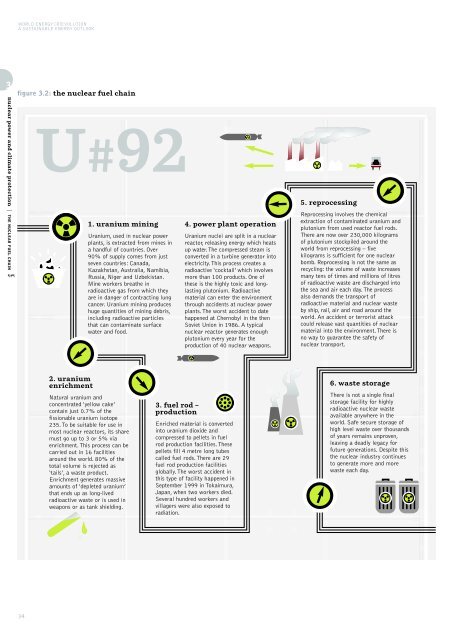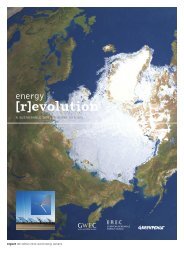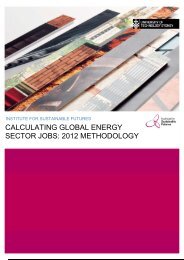download the mexico energy revolution scenario
download the mexico energy revolution scenario
download the mexico energy revolution scenario
Create successful ePaper yourself
Turn your PDF publications into a flip-book with our unique Google optimized e-Paper software.
WORLD ENERGY [R]EVOLUTION<br />
A SUSTAINABLE ENERGY OUTLOOK<br />
3<br />
nuclear power and climate protection | THE NUCLEAR FUEL CHAIN<br />
figure 3.2: <strong>the</strong> nuclear fuel chain<br />
U#92<br />
1. uranium mining<br />
Uranium, used in nuclear power<br />
plants, is extracted from mines in<br />
a handful of countries. Over<br />
90% of supply comes from just<br />
seven countries: Canada,<br />
Kazakhstan, Australia, Namibia,<br />
Russia, Niger and Uzbekistan.<br />
Mine workers brea<strong>the</strong> in<br />
radioactive gas from which <strong>the</strong>y<br />
are in danger of contracting lung<br />
cancer. Uranium mining produces<br />
huge quantities of mining debris,<br />
including radioactive particles<br />
that can contaminate surface<br />
water and food.<br />
4. power plant operation<br />
Uranium nuclei are split in a nuclear<br />
reactor, releasing <strong>energy</strong> which heats<br />
up water. The compressed steam is<br />
converted in a turbine generator into<br />
electricity. This process creates a<br />
radioactive ‘cocktail’ which involves<br />
more than 100 products. One of<br />
<strong>the</strong>se is <strong>the</strong> highly toxic and longlasting<br />
plutonium. Radioactive<br />
material can enter <strong>the</strong> environment<br />
through accidents at nuclear power<br />
plants. The worst accident to date<br />
happened at Chernobyl in <strong>the</strong> <strong>the</strong>n<br />
Soviet Union in 1986. A typical<br />
nuclear reactor generates enough<br />
plutonium every year for <strong>the</strong><br />
production of 40 nuclear weapons.<br />
5. reprocessing<br />
Reprocessing involves <strong>the</strong> chemical<br />
extraction of contaminated uranium and<br />
plutonium from used reactor fuel rods.<br />
There are now over 230,000 kilograms<br />
of plutonium stockpiled around <strong>the</strong><br />
world from reprocessing – five<br />
kilograms is sufficient for one nuclear<br />
bomb. Reprocessing is not <strong>the</strong> same as<br />
recycling: <strong>the</strong> volume of waste increases<br />
many tens of times and millions of litres<br />
of radioactive waste are discharged into<br />
<strong>the</strong> sea and air each day. The process<br />
also demands <strong>the</strong> transport of<br />
radioactive material and nuclear waste<br />
by ship, rail, air and road around <strong>the</strong><br />
world. An accident or terrorist attack<br />
could release vast quantities of nuclear<br />
material into <strong>the</strong> environment. There is<br />
no way to guarantee <strong>the</strong> safety of<br />
nuclear transport.<br />
2. uranium<br />
enrichment<br />
Natural uranium and<br />
concentrated ‘yellow cake’<br />
contain just 0.7% of <strong>the</strong><br />
fissionable uranium isotope<br />
235. To be suitable for use in<br />
most nuclear reactors, its share<br />
must go up to 3 or 5% via<br />
enrichment. This process can be<br />
carried out in 16 facilities<br />
around <strong>the</strong> world. 80% of <strong>the</strong><br />
total volume is rejected as<br />
‘tails’, a waste product.<br />
Enrichment generates massive<br />
amounts of ‘depleted uranium’<br />
that ends up as long-lived<br />
radioactive waste or is used in<br />
weapons or as tank shielding.<br />
3. fuel rod –<br />
production<br />
Enriched material is converted<br />
into uranium dioxide and<br />
compressed to pellets in fuel<br />
rod production facilities. These<br />
pellets fill 4 metre long tubes<br />
called fuel rods. There are 29<br />
fuel rod production facilities<br />
globally. The worst accident in<br />
this type of facility happened in<br />
September 1999 in Tokaimura,<br />
Japan, when two workers died.<br />
Several hundred workers and<br />
villagers were also exposed to<br />
radiation.<br />
6. waste storage<br />
There is not a single final<br />
storage facility for highly<br />
radioactive nuclear waste<br />
available anywhere in <strong>the</strong><br />
world. Safe secure storage of<br />
high level waste over thousands<br />
of years remains unproven,<br />
leaving a deadly legacy for<br />
future generations. Despite this<br />
<strong>the</strong> nuclear industry continues<br />
to generate more and more<br />
waste each day.<br />
34



![Energy [R]evolution - European Commission](https://img.yumpu.com/49109324/1/184x260/energy-revolution-european-commission.jpg?quality=85)


![5905 gp [eu rev]csfr4.qxd - Energy [R]evolution](https://img.yumpu.com/42305023/1/184x260/5905-gp-eu-revcsfr4qxd-energy-revolution.jpg?quality=85)


![5905 gp [eu rev]csfr4.qxd - Energy [R]evolution](https://img.yumpu.com/28729264/1/184x260/5905-gp-eu-revcsfr4qxd-energy-revolution.jpg?quality=85)